人教版初中八年级下册英语第四单元 Unit4集体备课教案教学设计
- 格式:doc
- 大小:721.50 KB
- 文档页数:26
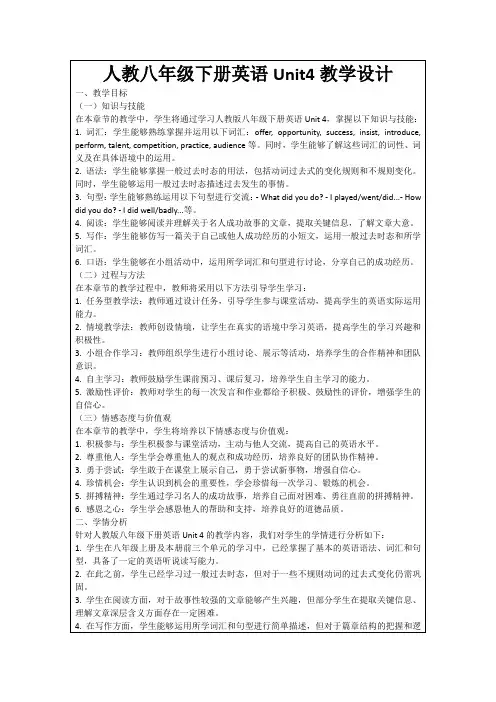
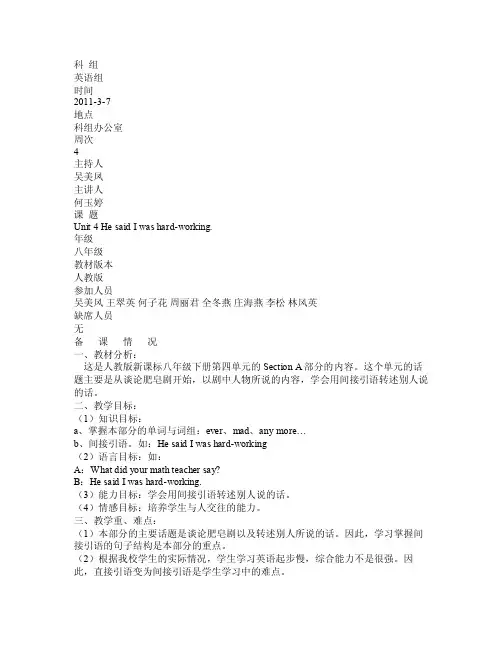
科组英语组时间2011-3-7地点科组办公室周次4主持人吴美凤主讲人何玉婷课题Unit4 HesaidI was hard-work ing.年级八年级教材版本人教版参加人员吴美风王翠英何子花周丽君全冬燕庄海燕李松林风英缺席人员无备课情况一、教材分析:这是人教版新课标八年级下册第四单元的Sec tionA部分的内容。
这个单元的话题主要是从谈论肥皂剧开始,以剧中人物所说的内容,学会用间接引语转述别人说的话。
二、教学目标:(1)知识目标:a、掌握本部分的单词与词组:e ver、m ad、an y mor e…b、间接引语。
如:HesaidI was hard-work ing(2)语言目标:如:A:Wha t did your math teac her s ay?B:He s aid I washard-worki ng.(3)能力目标:学会用间接引语转述别人说的话。
(4)情感目标:培养学生与人交往的能力。
三、教学重、难点:(1)本部分的主要话题是谈论肥皂剧以及转述别人所说的话。
因此,学习掌握间接引语的句子结构是本部分的重点。
(2)根据我校学生的实际情况,学生学习英语起步慢,综合能力不是很强。
因此,直接引语变为间接引语是学生学习中的难点。
四、教学过程(一)激趣课堂在本活动中,我告诉学生们说:今天晚上电视台将播出一部卡通片,大家想看吗?这些就是剧中的人物,片名是“Young liv es” 它是一部肥皂剧。
根据学生的心理,如果学生对于一件事物有极大的兴趣,他们就会排除主观和客气的种种消极因素,全身心地投入到知识的学习中。
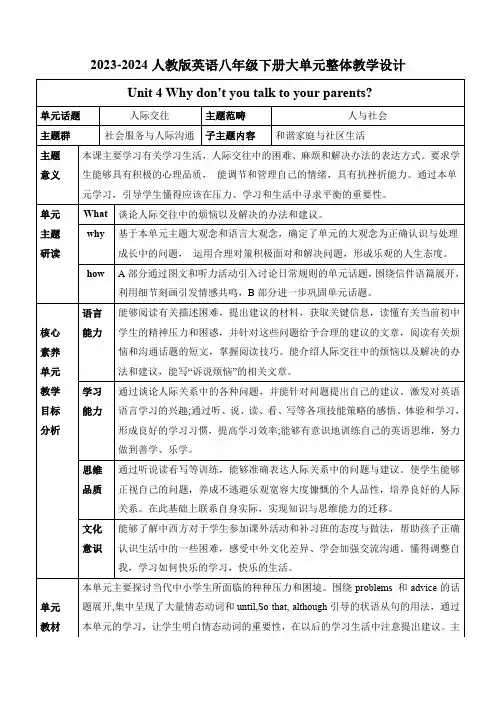
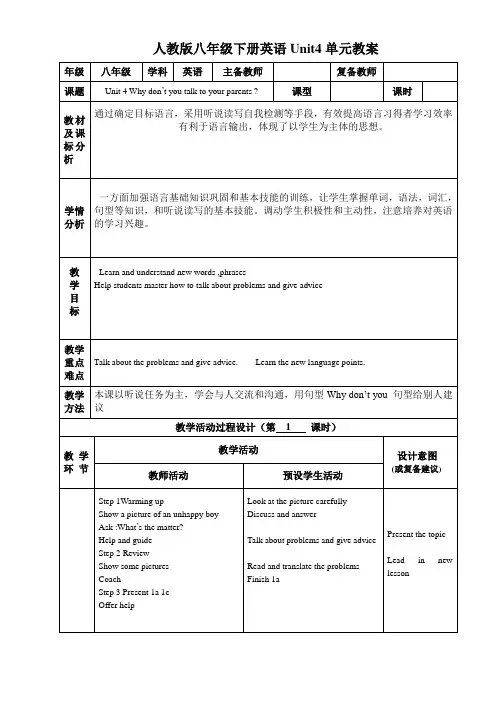
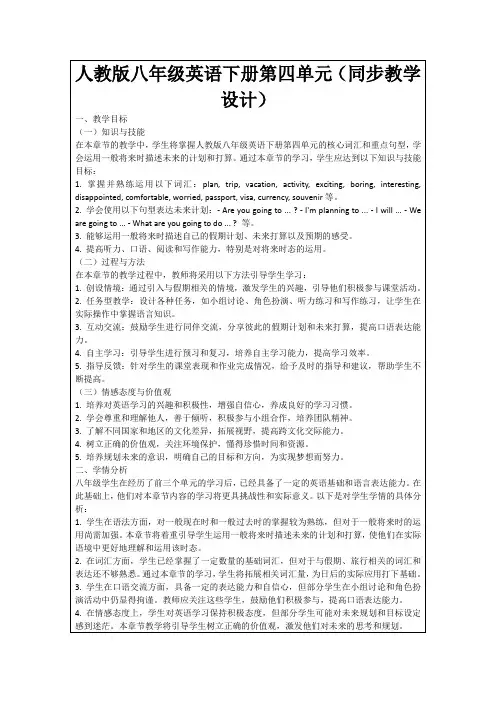
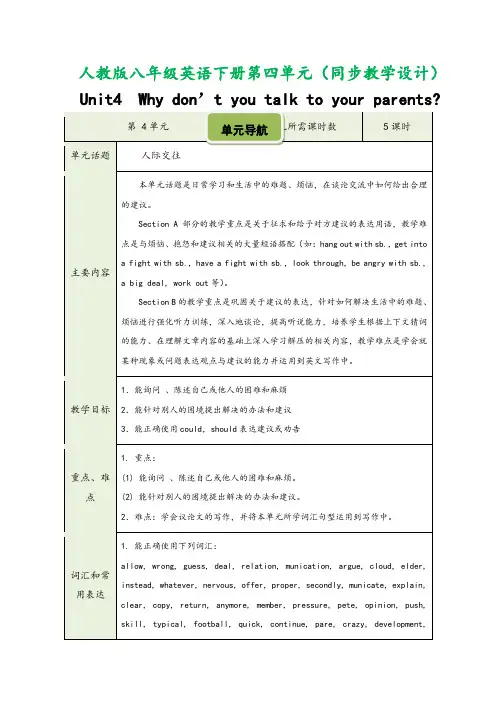
人教版八年级英语下册第四单元(同步教学设计)Unit4 Why don’t you talk to your parents?Unit 4 Why don’t you talk to your parents?Unit 4 Could you please clean your room?get along with—get on with He is getting on well with his newfriends.Step 4 Grammar focus1. Let Ss read the Grammar table and summarize.(1) 提出问题What’s wrong?What’s the matter? + with sb.What’s the problem/the trouble?(2) 给出建议情态动词should, should等should, shouldn’t常用来提出请求和建议could 也可用来给出建议。
表建议的句型:You should/could +v. Why don’t you + v.?Why not + v.? Could you please + v.?You’d better (not) + v.. Would you mind doing…?What about/How about + n./doing…?(3) 引导状语从句的连词although 即使,尽管 until 直到……为止so that 结果,因此2. Let Ss finish 4a and check the answers.Answers: 1. so that 2. Although 3. until 4. Although3. Give Ss several problems. Let Ss write one piece of advice for each problem. Then pare their advice with their partners’ and decide whether the advice is good or bad.Problems:(1)I’m very shy.(2)My sister and I fight all the time.Unit 4 Why don’t you talk to your parents?Unit 4 Why don’t you talk to your parents?Unit 4 Why don’t you talk to your parents?U nit 4 Why don’t you talk to your parents?老师在上课前,播放一段视频,向学生提出问题,通过对话引入本课时主题,引发学生共鸣,导入新课。
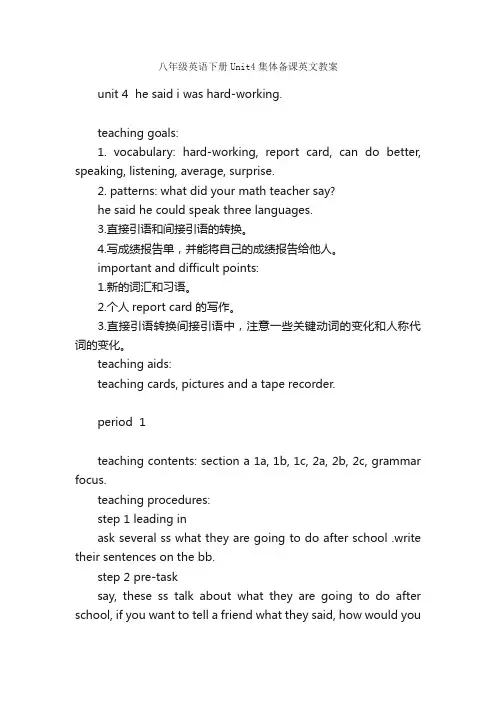
八年级英语下册Unit4集体备课英文教案unit 4 he said i was hard-working.teaching goals:1. vocabulary: hard-working, report card, can do better, speaking, listening, average, surprise.2. patterns: what did your math teacher say?he said he could speak three languages.3.直接引语和间接引语的转换。
4.写成绩报告单,并能将自己的成绩报告给他人。
important and difficult points:1.新的词汇和习语。
2.个人report card 的写作。
3.直接引语转换间接引语中,注意一些关键动词的变化和人称代词的变化。
teaching aids:teaching cards, pictures and a tape recorder.period 1teaching contents: section a 1a, 1b, 1c, 2a, 2b, 2c, grammar focus.teaching procedures:step 1 leading inask several ss what they are going to do after school .write their sentences on the bb.step 2 pre-tasksay, these ss talk about what they are going to do after school, if you want to tell a friend what they said, how would youtell him?write the words “he said” and “she said” on the bb .say, we can use the words “he said” and “she said” to tell your friend like this: he/she said he/she was going to play basketball after school .get the ss to repeat.repeat this process with the other sentences on the bb.step 3 while-tasksb page 26, 1a.1. ask a student to read the four questions.(1) what is a soap opera?(2) do you ever watch soap operas?(3) what are some soap operas you known?(4) what are some things that happen on soap operas?2. write the words soap opera on the board. point to the picture and ask students what they think a soap opera is.3. point out the tv screens in the picture. ask one student to read what the person says in the first picture .then ask another student: what did she/he say? help to answer: she/he said she/he was having a surprise party for lana on friday night.4. repeat with the other pictures.sb page 26 , 1b .ask different students to look at each picture and tell what is happening.play the recording the first time. students only listen.play the recording a second time and write the numbers 1 though 4 in front of the pictures. then check the answers.sb page 26, 1c.pairwork. first ss work in pairs, then ask some pairs to present their dialogues to the class.step 4 post-tasksb page 27 , 2a & 2b .1. ask several ss to read these sentences.2. play the recording .ss circle their answer.3. check the answers.step 5 grammar focus1. review the grammar box. ask ss to say the statements.2. explain: in each case, the direct speech talks about present situations and the reported speech talks about past situations .。
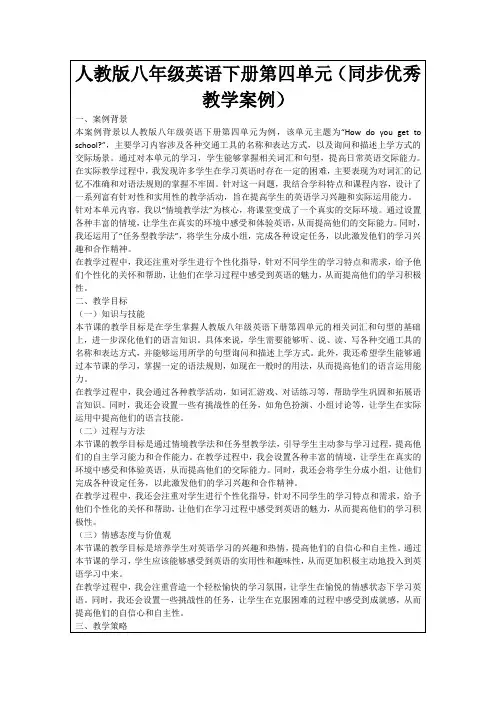
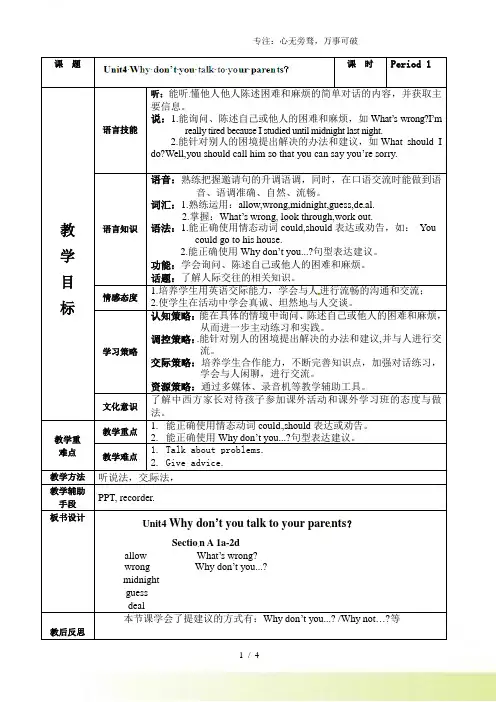
课题课时Period 1教学目标语言技能听:能听懂他人他人陈述困难和麻烦的简单对话的内容,并获取主要信息。
说:1.能询问、陈述自己或他人的困难和麻烦,如What’s wrong?I’m really tired because I studied until midnight last night.2.能针对别人的困境提出解决的办法和建议,如What should Ido?Well,you should call him so that you can say you’re sorry.语言知识语音:熟练把握邀请句的升调语调,同时,在口语交流时能做到语音、语调准确、自然、流畅。
词汇:1.熟练运用:allow,wrong,midnight,guess,de al.2.掌握:What’s wrong, look through,work out.语法:1.能正确使用情态动词could,should表达或劝告,如:Youcould go to his house.2.能正确使用Why don’t you...?句型表达建议。
功能:学会询问、陈述自己或他人的困难和麻烦。
话题:了解人际交往的相关知识。
情感态度1.培养学生用英语交际能力,学会与人进行流畅的沟通和交流;2.使学生在活动中学会真诚、坦然地与人交谈。
学习策略认知策略:能在具体的情境中询问、陈述自己或他人的困难和麻烦,从而进一步主动练习和实践。
调控策略:.能针对别人的困境提出解决的办法和建议,并与人进行交流。
交际策略:培养学生合作能力,不断完善知识点,加强对话练习,学会与人闲聊,进行交流。
资源策略:通过多媒体、录音机等教学辅助工具。
文化意识了解中西方家长对待孩子参加课外活动和课外学习班的态度与做法。
教学重难点教学重点1.能正确使用情态动词could,should表达或劝告。
2.能正确使用Why don’t you...?句型表达建议。
教学难点1.Talk about problems.2.Give advice.教学方法听说法,交际法,教学辅助手段PPT, recorder.板书设计Unit4 Why don’t you talk to your parents?Sectio n A 1a-2dallow What’s wrong?wrong Why don’t you...?midnightguessdeal教后反思本节课学会了提建议的方式有:Why don’t you...? /Why not…?等Teaching ProcedureStages/TimingStep 1. warming-upStep 2 PresentationStep3 DiscussionStep 4Pre sentationStep 5 ListeningTeach ers’ a ctivitiesAfter greeting, ask students :What day is it today?What’s the date today?What’s the weather like today?1. Show the picture of a girl:T: Please look at this girl,what isshe doing?T: Look at her face,she isworried.because she has a lotof homework to do.Do yo uhave too much homework todo?Do you think it is serious?1a.Get them to read the followingsentences and discuss wheatherthey are serious or not. And thenwrite them in the approprite boxT:Do you have theseproblems?What kind of problemsdo you have?Students’ activitiesStudents answer the questions。
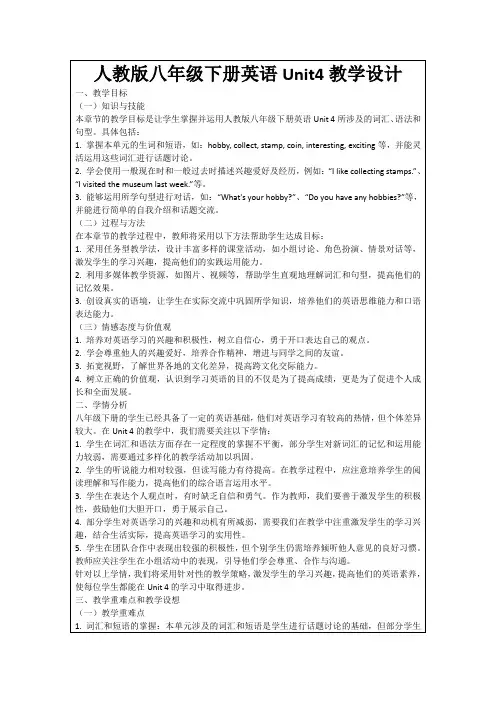
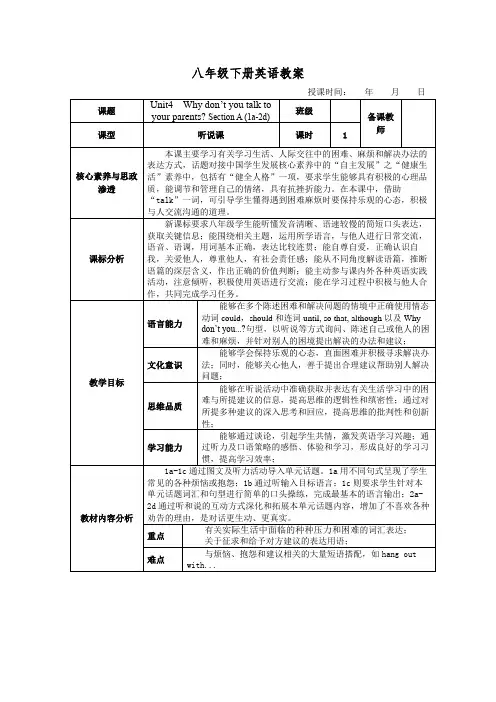
Section A 单词allow v.允许;准许wrong adj.有毛病;错误的guess v.猜测;估计deal n.协议;交易relation n.关系;联系;交往communication n.交流;沟通argue v.争吵;争论cloud n.云;云朵elder n.年纪较长的instead adv.代替;反而;却whatever pron.任何;每一nervous adj.焦虑的;担忧的offer v.主动提出;自愿给予proper adj.正确的;恰当的secondly adv.第二;其次communicate v.交流;沟通explain v.解释;说明clear adj.清楚易懂的;晴朗的copy v.抄袭;模仿;复制;复印return v.归还;回来;返回anymore adv.(常用于否定句和疑问句句末)再也(不);(不)再短语look through快速查看;浏览big deal重要的事work out成功地发展;解决get on with和睦相处;关系良好句型1.Many of them are learning exam skills so that they can get into a good high school and later a good university.他们中很多人正在学习应试技巧以便能考入一所好高中,进而升入一所好大学。
2.The Taylors are a typical American family.泰勒家就是一个典型的美国家庭。
3.And they are always comparing them with other children.而且她们总是将自己的孩子和别的孩子相比较。
语法although, so that及until引导的状语从句知识目标掌握课文中的重点词汇及相关短语,并灵活运用。
能力目标学会谈论问题和给出建议情感目标遇到问题要主动地去和家人、朋友或亲近的人交流;如果身边的人遇到问题,能主动提供帮助;要学会放松、缓解压力。
【课时建议】本单元建议5课时Section A (1a~2d)………………………………………………………………………………………1课时Section A (3a~4c)……………………………………………………………………………………1课时Section B (1a~1e)……………………………………………………………………………………1课时Section B (2a~2e)……………………………………………………………………………………1课时Section B (3c~3b)……………………………………………………………………………………1课时词汇短语:主要采用图片及多媒体展示助记法。
基本句子:利用多媒体展示及交际法(利用多媒体展示两人进行交际时的情景)。
语法:通过句子练习让学生认识连词until, so that及although引导的状语从句。
学习why don’t you…?等提建议的句型。
Section A 第一课时(1a~2d)类别学习重点重点单词allow, wrong, guess, deal重点短语work out, allow sb. to do sth., look through, a big deal重点句式1.What’s wrong?2.I’m really tired because I studied until midnight last night.3.Why don’t you forget about it so that you can be friends again?课前预习写一写1.允许;准许allow2.错误的wrong3.猜测;估计guess4.协议;交易deal 译一译1.成功地发展;解决work out2.允许某人做某事allow sb. to do sth.3.与某人争吵get into a fight with sb.4.快速查看;浏览look through5.重要的事big deal背一背1.我真的很累,因为昨晚一直学习到半夜。
I’m really tired because I studied until midnig ht last night. 2.为什么不忘记它,这样你们能再次成为好朋友?Why don’t you forget about it so that you can be friends again?新课导入Let one student dress up as a worried one and the teacher has a conversation with him.T:What’s wrong? Y ou look worried.S1:Yes.I got into a fi ght with my best friend. But I don’t know how to do it. So I need your help.T:I think you should talk to him. (towards other students) Do you have any other advice?S2:I think you should say sorry to him.S3:Why don’t you write a letter to him?S4:…新课展示【完成教材1a~1c的教学任务】1.学生朗读并记忆1a中的句子为听力作准备。
2.学生讨论并完成1a的任务。
3.听录音,在1a中圈出你所听到的问题,再听并跟读。
4.练习1c中的对话,并用1a中的问题与同伴模仿1c中的对话编造新的对话,然后Although he is very poor,he is ready to help others.尽管他很穷,但他总是乐于助人。
although/though作连词,意为“虽然;尽管”,这两个词都不能与but连用,即用了although/ though就不能再用but。
不过although可以与yet/still 一起使用。
例句:尽管他身体不好,但是他工作很努力。
正:Although/Though he is in poor health,he works hard.误:Although he is in poor health,but he works hard.even though/if(即使;尽管)和as though/if(好像;仿佛)这两个词组中的though不可以换为although。
【问题探究】根据汉语意思完成句子。
1.我发现他正在抽烟。
I found him smoking .2.(江西中考) C the girl is only nine, she takes care of her brother and cooks meals every day.A. IfB. BecauseC. AlthoughD.As活学活练翻译句子。
1.我发现我的妹妹正在翻阅我的东西。
I found my sister looking through my things.2.即使是她错了,那也不是什么大不了的事情。
Although she is wrong, it’s not a big deal.布置作业:教师引导学生课后完成本课时对应练习,并预习下一课时内容。
教学反思本课时以模拟现实情景对话的方式引入话题,既勾起了学生的表演欲望,也能带动课堂气氛,使学生参与到课堂中来,增强了英语教学的趣味性。
教学过程中老师的疑问:教师点评和总结:教学说明:通过贴近现实生活的情景教学,激起学生的表达欲望,引起学生的学习兴趣。
教学说明:通过学习1a,使学生对提建议的句型有所了解,并扩宽思路;通过1b的练习锻炼学生的听力。
Section A 第二课时(3a~4c)类别学习重点重点单词relation, communication, argue, cloud, elder, instead, whatever, nervous,offer, proper, secondly, communicate, explain, clear, copy, return, anymore 重点短语get on with, communicate with重点句式1.Instead he watches whatever he wants until late at night.2.It’s not easy being your age.课前预习写一写1.关系;交往relation2.交流;沟通communication3.争吵;争论argue4.云;云朵cloud5.年纪较长的elder6.代替;反而;却instead7.任何;每一whatever8.焦虑的;担忧的nervous 9.主动提出;自愿给予offer10.正确的;恰当的proper 11.第二;其次secondly12.交流;沟通communicate 13.解释;说明explain14.清楚易懂的;晴朗的clear 15.抄袭;模仿copy16.归还;回来return 17.再也(不);(不)再anymore译一译 1.和睦相处;关系良好get on with 2.与……交流communicate with背一背1.而他却看任何他想看的节目直到深夜。
Instead he watches whatever he wants until late at night.2.在你这个年龄不容易。
It’s not easy being your age.新课导入Teacher: Sad and Thirteen is a boy, now he is very sad. He can’t get on well with his family. Do you want to know what happened to him and his family on earth? Let’s read the letters together.新课展示【完成教材3a~3b的教学任务】1.阅读3a中的两封信件,总结出Sad and Thirteen的烦恼以及Robert Hunt给出的建议,完成后让学生展示自己的答案,教师点拨。
2.认真阅读3a表格中的烦恼和建议,你同意Robert Hunt给出的建议吗?在小组内发表你的观点。
而且你还可以提出解决问题的更好的建议。
3.再次细心阅读短文,理解每一句话的意思,小组合作解决遇到的疑难问题。